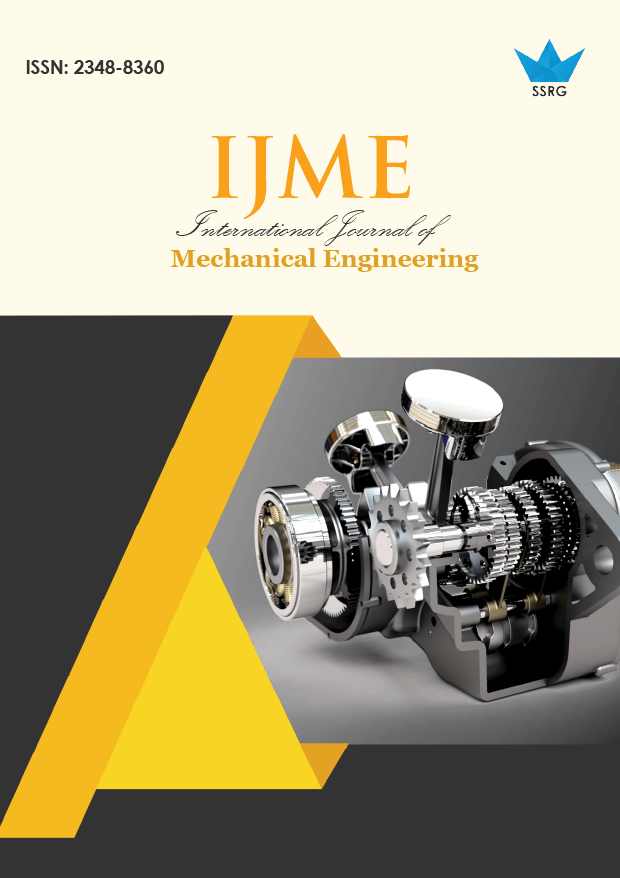Design Optimization for SG6043 Airfoil for Using Finite Elements Analysis

| International Journal of Mechanical Engineering |
| © 2025 by SSRG - IJME Journal |
| Volume 12 Issue 9 |
| Year of Publication : 2025 |
| Authors : Maher Rehaif Khudhair |
How to Cite?
Maher Rehaif Khudhair, "Design Optimization for SG6043 Airfoil for Using Finite Elements Analysis," SSRG International Journal of Mechanical Engineering, vol. 12, no. 9, pp. 91-96, 2025. Crossref, https://doi.org/10.14445/23488360/IJME-V12I9P109
Abstract:
The importance of wind turbine blade aerodynamics cannot be emphasized enough in extending energy capture from wind. However, conventional design approaches are often challenged to balance high lift forces for efficient power generation and minimize drag forces that reduce energy losses. Thus, a more systemic methodology should be used to improve the efficiency of airfoils. In this study, an adjoint optimization solver is used to achieve both drag reduction and a high Lift-to-Drag (L/D) ratio while adhering to real-time wind conditions. The optimization procedure includes selecting the initial airfoil design and optimization algorithm, prespecifying constraints and objectives, executing the model, analyzing results, and troubleshooting and refining until the targeted reduction in drag and/or fulfillment of constraints is achieved. The developed airfoil model achieved a 9% decrease in drag and a 2% increase in the L/D ratio when the airfoil camber was expanded via a larger suction zone at the leading edge. The optimization strategy used the well-known SG6043 airfoil as an initial model widely used in wind turbine blades. The results demonstrated significant improvements in aerodynamic performance through enhanced camber and suction zone modifications at the leading edge of the airfoil, providing valuable insights for advancing airfoil designs for optimal performance across various applications.
Keywords:
Geometry, Optimization, Aerodynamic Performance, Airfoil, Lift Coefficient, Adjoint Solver.
References:
[1] Erich Hau, The Wind Resource, Wind Turbines: Fundamentals, Technologies, Application, Economics, pp. 505-547, 2013.
[Google Scholar] [CrossRef] [Publisher Link]
[2] Akira Oyama, Meng-Sing Liou, and Shigeru Obayashi, “Transonic Axial-Flow Blade Optimization: Evolutionary Algorithms/Three-Dimensional Navier-Stokes Solver,” Journal of Propulsion and Power, vol. 20, no. 4, pp. 612-619, 2004.
[CrossRef] [Google Scholar] [Publisher Link]
[3] A. Semenova et al., “Multi-Objective Shape Optimization of Runner Blade for Kaplan Turbine,” IOP Conference Series: Earth and Environmental Science: Design and Optimization of Hydraulic Machines, vol. 22, pp. 1-10, 2014.
[CrossRef] [Google Scholar] [Publisher Link]
[4] Chalothorn Thumthae, and Tawit Chitsomboon, “Optimal Angle of Attack for Untwisted Blade Wind Turbine,” Renew Energy, vol. 34, no. 5, pp. 1279-1284, 2009.
[CrossRef] [Google Scholar] [Publisher Link]
[5] J.L. Tangler, and D.M. Somers, “NREL Airfoil Families for HAWTs,” National Renewable Energy Lab. (NREL), Golden, pp. 1-12, 1994.
[CrossRef] [Google Scholar] [Publisher Link]
[6] Jianhua Xu et al., “Design Optimization of a Multi-Megawatt Wind Turbine Blade with the NPU-MWA Airfoil Family,” Energies, vol. 12, no. 17, pp. 1-24, 2019.
[CrossRef] [Google Scholar] [Publisher Link]
[7] Ava Shahrokhi, and Alireza Jahangirian, “Airfoil Shape Parameterization for Optimum Navier–Stokes Design with Genetic Algorithm,” Aerospace Science and Technology, vol. 11, no. 6, pp. 443-450, 2007.
[CrossRef] [Google Scholar] [Publisher Link]
[8] Md. Tausif Akram, and Man-Hoe Kim, “Aerodynamic Shape Optimization of NREL S809 Airfoil for Wind Turbine Blades Using Reynolds-Averaged Navier Stokes Model—Part II,” Applied Sciences, vol. 11, no. 5, pp. 1-24, 2021.
[CrossRef] [Google Scholar] [Publisher Link]
[9] Yang Zhang et al., “Aerodynamic Shape Optimization with Grassmannian Shape Parameterization Method,” Energies, vol. 15, no. 20, pp. 1-13, 2022.
[CrossRef] [Google Scholar] [Publisher Link]
[10] Christian V. Rodriguez, and Cesar Celis, “Design Optimization Methodology of Small Horizontal Axis Wind Turbine Blades using a Hybrid CFD/BEM/GA Approach,” Journal of the Brazilian Society of Mechanical Sciences and Engineering, vol. 44, 2022.
[CrossRef] [Google Scholar] [Publisher Link]
[11] Tianshu Liu, “Evolutionary Understanding of Airfoil Lift,” Advances in Aerodynamics, vol. 3, pp. 1-24, 2021.
[CrossRef] [Google Scholar] [Publisher Link]
[12] Y. El khchine, and M. Sriti, “Improved Blade Element Momentum theory (BEM) for Predicting the Aerodynamic Performances of Horizontal Axis Wind Turbine Blade (HAWT),” Technische Mechanik, vol. 38, no. 2, pp. 191-202, 2018.
[CrossRef] [Google Scholar] [Publisher Link]
[13] Jinane Radi et al., “Metaheuristic Optimization of Wind Turbine Airfoils with Maximum-Thickness and Angle-of-Attack Constraints,” Energies, vol. 17, no. 24, pp. 1-21, 2024.
[CrossRef] [Google Scholar] [Publisher Link]
[14] Ahmed Kadhim Zarzoor, Ahmed Adnan Shandookh, and Alaa Abdulhady Jaber, “Analysis of 5 MW NREL Wind Turbine Using Qblade Software,” International Conference on Network, Multimedia and Information Technology, Bengaluru, India, pp. 1-7, 2023.
[CrossRef] [Google Scholar] [Publisher Link]
[15] Vis Sripawadkul, Mattia Padulo, and Marin Guenov, “A Comparison of Airfoil Shape Parameterization Techniques for Early Design Optimization,” 13th AIAA/ISSMO Multidisciplinary Analysis Optimization Conference, 2010.
[CrossRef] [Google Scholar] [Publisher Link]
[16] Jin Chen, and Quan Wang, Wind Turbine Airfoils and Blades: Optimization Design Theory, Walter de Gruyter GmbH & Co KG, vol. 3, pp. 1-392, 2017.
[Google Scholar] [Publisher Link]
[17] Peter Fuglsang, and Christian Bak, “Development of the Risø Wind Turbine Airfoils,” Wind Energy: An International Journal for Progress and Applications in Wind Power Conversion Technology, vol. 7, no. 2, pp. 145-162, 2004.
[CrossRef] [Google Scholar] [Publisher Link]
[18] Prashant Sharma et al., “Recent Advancements in Optimization Methods for Wind Turbine Airfoil Design: A Review,” Materials Today Proceedings, vol. 47, pp. 6556-6563, 2021.
[CrossRef] [Google Scholar] [Publisher Link]
[19] G. Carpentieri, B. Koren, and M.J. L. van Tooren, “Adjoint-Based Aerodynamic Shape Optimization on Unstructured Meshes,” Journal of Computational Physics, vol. 224, no. 1, pp. 267-287, 2007.
[CrossRef] [Google Scholar] [Publisher Link]
[20] Kun Wang et al., “Adjoint-Based Airfoil Optimization with Adaptive Isogeometric Discontinuous Galerkin Method,” Computer Methods in Applied Mechanics and Engineering, vol. 344, pp. 602-625, 2019.
[CrossRef] [Google Scholar] [Publisher Link]
[21] Pedro Gomes, and Rafael Palacios, “Aerodynamic-Driven Topology Optimization of Compliant Airfoils,” Structural and Multidisciplinary ssOptimization, vol. 62, pp. 2117-2130, 2020.
[CrossRef] [Google Scholar] [Publisher Link]

 10.14445/23488360/IJME-V12I9P109
10.14445/23488360/IJME-V12I9P109